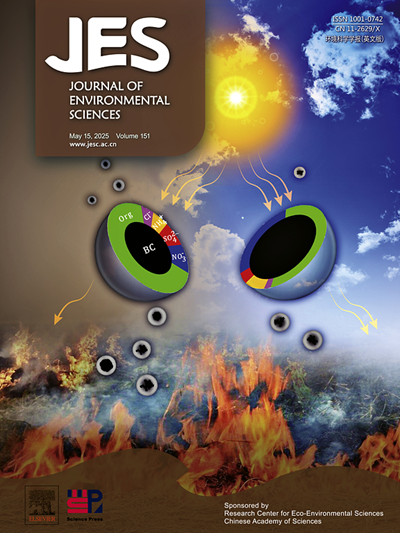UV-light-promoted synthesis of a double Z-scheme BN/C60/g-C3N4 heterojunction with enhanced photodegradation performance for antibiotics
IF 5.9
2区 环境科学与生态学
Q1 ENVIRONMENTAL SCIENCES
引用次数: 0
Abstract
Developing environmental-friendly non-metal photocatalysts for the efficient removal of antibiotics from environment is a significant challenge. The construction of heterojunction is regarded as a powerful strategy to enhance the photodegradation efficiency of photocatalysts for pollutants, being due that this strategy can effectively suppress the recombination of the photo-induced electron and hole. In this research, a novel double Z-scheme BN/C60/g-C3N4 heterojunction was successfully synthesized via one-step synthetic approach. Based on a series of experimental characterization, BN/C60/g-C3N4 is most likely formed via the interaction between N element of BN and g-C3N4 with C60 under UV-light irradiation. The band structures of BN, C60, g-C3N4 and the internal electric field among them suggest that BN/C60/g-C3N4 may has a direct double z-type band arrangement, which facilitates efficient charge transfer. The photodegradation rate of BN/C60/g-C3N4 for tetracycline reached 90.1 %, which is 2.9 times higher than that observed with BN and 2.3 times higher than that of g-C3N4. BN/C60/g-C3N4 exhibits remarkable photocatalytic performance across a wide pH range and in the influence of different anions. This study offers significant insights about how to design double z-scheme metal-free photocatalyst with high photodegradation efficiency for antibiotic.

紫外光催化合成双z型BN/C60/g-C3N4异质结,增强抗生素的光降解性能
开发环境友好型非金属光催化剂,有效地去除环境中的抗生素是一项重大挑战。异质结的构建被认为是提高光催化剂对污染物光降解效率的一种有效策略,因为这种策略可以有效地抑制光诱导电子与空穴的复合。本研究通过一步法成功合成了一种新型的双z型BN/C60/g-C3N4异质结。通过一系列实验表征,BN/C60/g-C3N4极有可能是BN和g-C3N4中的N元素在紫外线照射下与C60相互作用形成的。BN、C60和g-C3N4的能带结构及其内部电场表明,BN/C60/g-C3N4可能具有直接的双z型能带排列,有利于有效的电荷转移。BN/C60/g-C3N4对四环素的光降解率达到90.1%,比BN高2.9倍,比g-C3N4高2.3倍。BN/C60/g-C3N4在较宽的pH范围和不同阴离子的影响下均表现出优异的光催化性能。该研究对如何设计具有高光降解效率的双z型无金属光催化剂具有重要的指导意义。
本文章由计算机程序翻译,如有差异,请以英文原文为准。
求助全文
约1分钟内获得全文
求助全文
来源期刊

Journal of Environmental Sciences-china
环境科学-环境科学
CiteScore
13.70
自引率
0.00%
发文量
6354
审稿时长
2.6 months
期刊介绍:
The Journal of Environmental Sciences is an international journal started in 1989. The journal is devoted to publish original, peer-reviewed research papers on main aspects of environmental sciences, such as environmental chemistry, environmental biology, ecology, geosciences and environmental physics. Appropriate subjects include basic and applied research on atmospheric, terrestrial and aquatic environments, pollution control and abatement technology, conservation of natural resources, environmental health and toxicology. Announcements of international environmental science meetings and other recent information are also included.
 求助内容:
求助内容: 应助结果提醒方式:
应助结果提醒方式:


